Pennsylvania has several natural waterways, which makes it a desirable location for white water rafting. Both novice and expert outdoor paddlers can easily find excellent trips in Pennsylvania, regardless of whether they choose to paddle on the Youghiogheny or float through the waves on one of the numerous furious river segments.
Let’s take a look at the best rivers in the state that have excellent rafting conditions!
1. Youghiogheny River
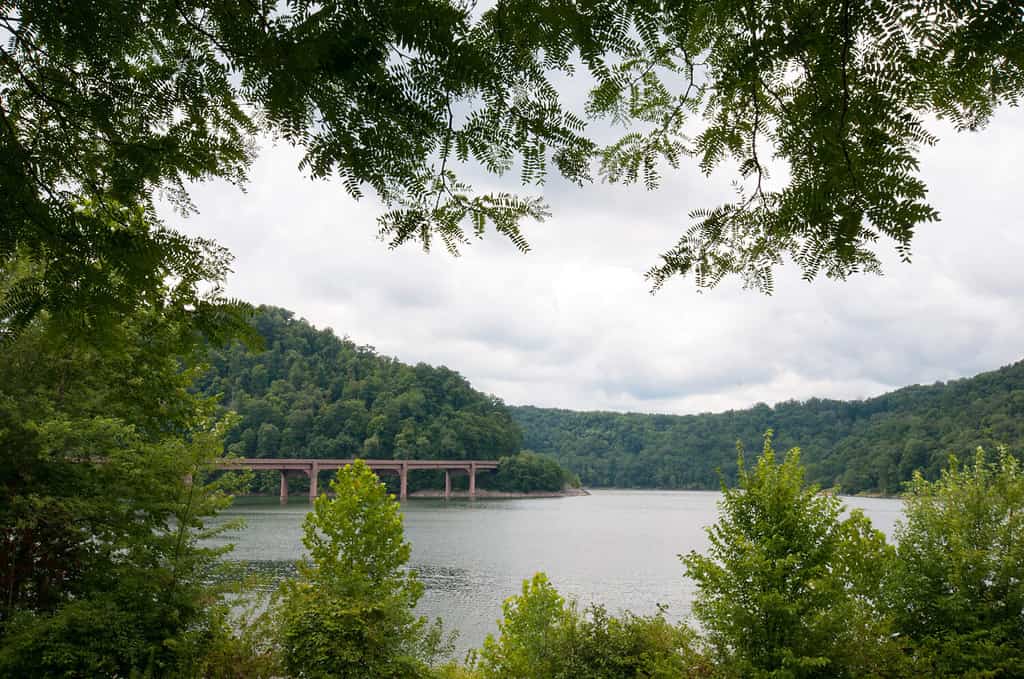
The Youghiogheny River has nearly 40 miles of shoreline.
©Nancy Bauer/Shutterstock.com
In the Laurel Highlands area of southern Pennsylvania, the Youghiogheny River passes through Ohiopyle, one of Pennsylvania’s biggest state parks. Locals refer to it as the Yough. White water rafting and kayaking are popular activities on the river.
The most popular area of the river is a section locals call “The Loop.” It consists of a mile-and-a-half stretch of the Lower Yough. Since paddlers can use the loop without a transport vehicle, it is ideal for them.
Because every segment of the river appeals to a distinct type of experience, it provides the best white water rafting in Pennsylvania. If you choose this river, you’ll enjoy nearly eight miles of class III and IV rapids!
For beginners or those who favor gentle rafting, the nine-mile Middle Yough is a great segment. Adrenaline enthusiasts searching for challenging class IV and V rapids belong at the Upper Yough.
2. Stonycreek River

The Glessner Bridge goes over the river and was built in 1881.
©Joseph Gruber/Shutterstock.com
Near Johnstown, there is a specially created whitewater excursion called Stonycreek Whitewater Park for paddlers. On a stretch of the Stonycreek River next to Greenhouse Park, the park features simulated rapids.
This is a great location to improve your skills and pick up the fundamentals of white water rafting. The majority of rapids are Class II, providing just the right amount of difficulty to teach you how to handle more challenging natural whitewater.
You may organize your expedition around the water conditions thanks to scheduled discharges of surging water from Stonycreek Canyon
3. Allegheny River Water Trail
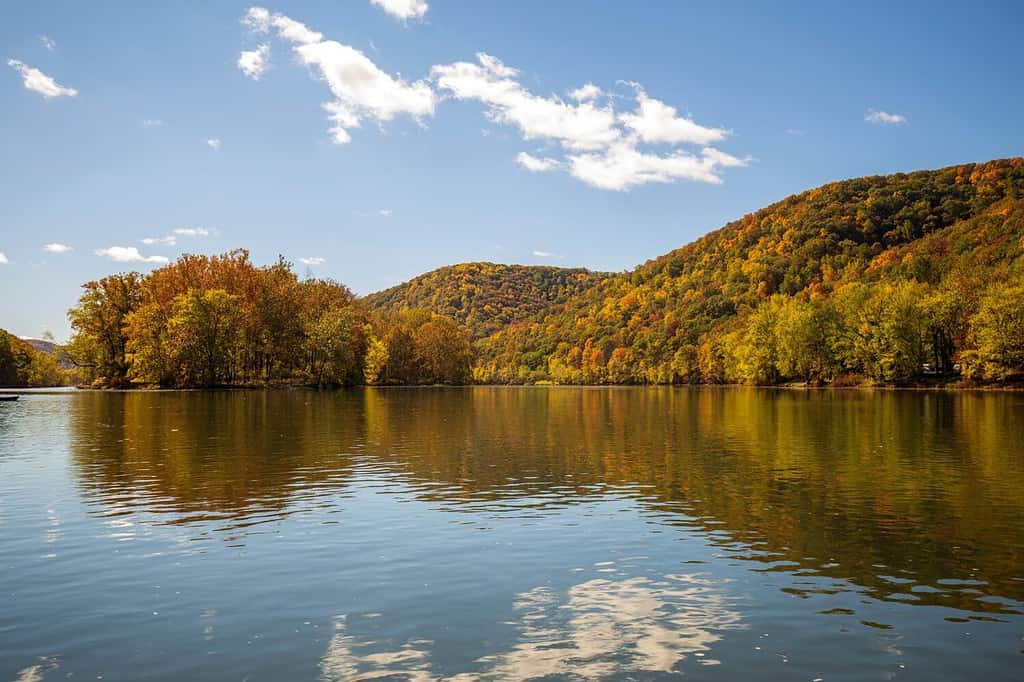
There are hidden waterfalls along the Allegheny River.
©Piper VanOrd/Shutterstock.com
The Allegheny River Water Trail is a popular spot for white water rafting among both tourists and locals. Despite the 85 miles of the path, you should focus on a certain section according to your skills and interests.
The region close to Oil City is where those seeking some of Pennsylvania’s raging white water thrills should visit. You will enjoy some untamed natural beauty in addition to the powerful rapids. People rafting will enjoy water activities outside of the Oil City sector.
You can float slowly along the river, which is recognized as a National Wild and Scenic Recreational River. This is a great place to see animals in Pennsylvania. It’s not uncommon to spot bald eagles here!
4. Lehigh River
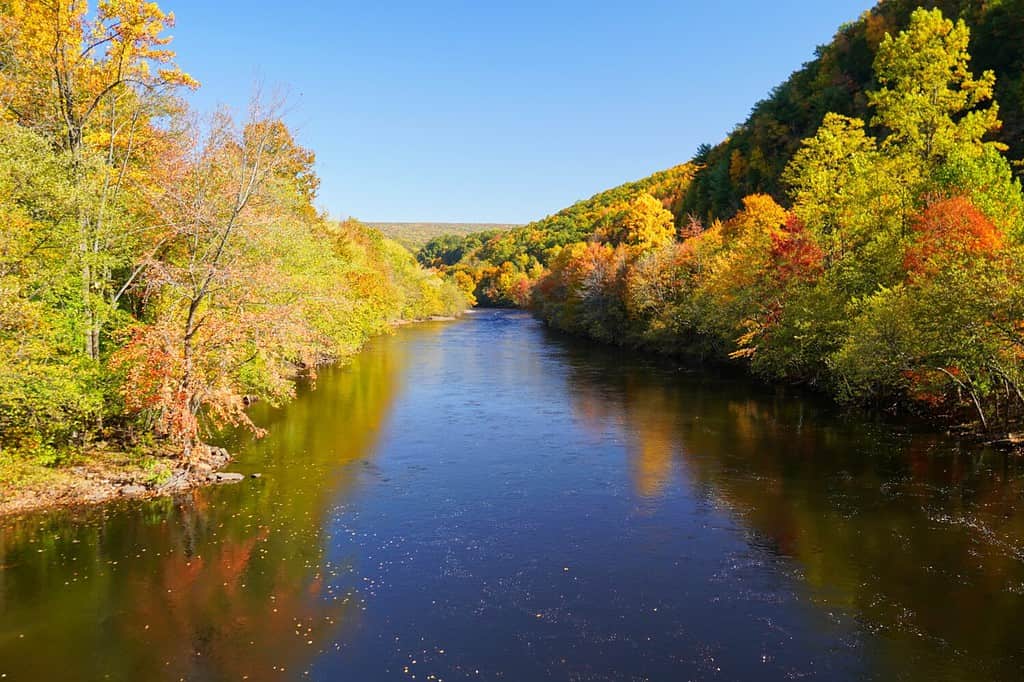
People paddle the Lehigh River in the fall to see the incredible foliage.
©PT Hamilton/Shutterstock.com
One of the best locations in Pennsylvania for whitewater rafting is the Lehigh River. It draws in many visitors because it’s within the Pocono Mountains. On this waterway, you’ll find Class I, II, and III rapids.
When you’re on the water, you’ll be able to paddle between the Appalachian and Poconos Mountains. A wilderness area has been conserved here. This 32-mile stretch of smoother water is a common destination for paddlers to start from the White Haven segment.
Susquehanna River Water Trail
You can go on a child-friendly float trip or practice your paddling abilities on moderate waters thanks to these relatively calm rapids. On days when the dam is released, the waves and water surges are enhanced, so if you’re in the mood for a little more action, try the rapids.
5. Three Rivers Water Trail
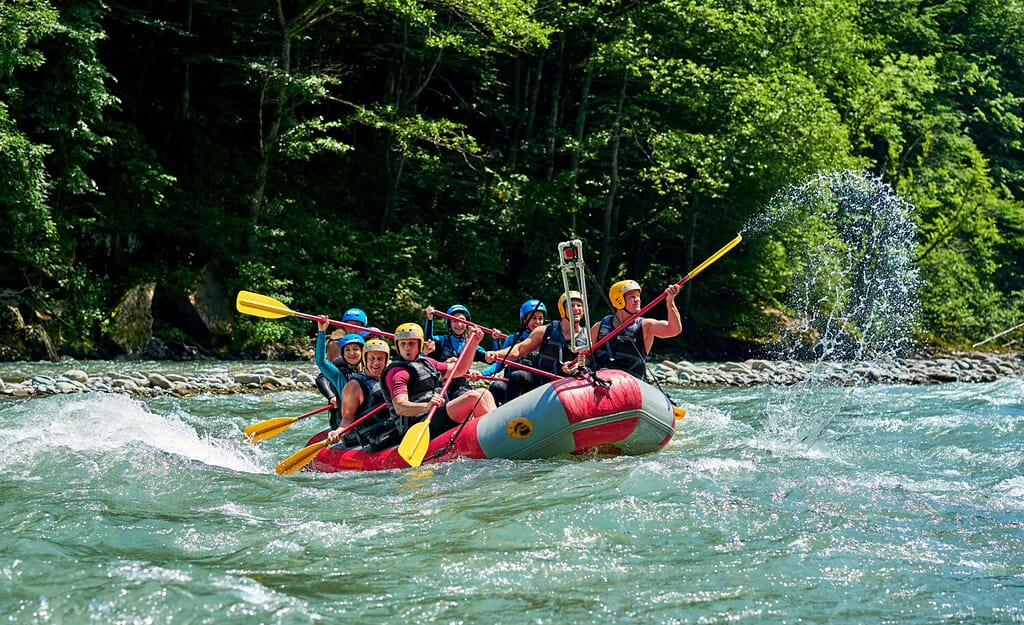
If you’re looking for a rafting spot near Pittsburgh, consider the Three Rivers Water Trail.
©Aleksandr Lupin/Shutterstock.com
If you’re looking for a spot where you don’t need a permit to reach the access points, consider Three Rivers Water Trail. A notable city waterway for paddlers is Pittsburgh’s Three Rivers Water Trail in Point State Park.
Plenty of parking and readily accessible launch places are present. Boaters can travel 75 miles along the Three Rivers Water Trail, which passes along the Allegheny, Monongahela, Youghiogheny, and Ohio Rivers.
It has 90 riverside towns as well as entry locations, and it is regarded as a National Recreation Trail. Those rafting who are unfamiliar with the area can identify the trail’s launch and exit sites as well as other facilities like meals and lodging thanks to its clear markings.
6. Schuylkill River
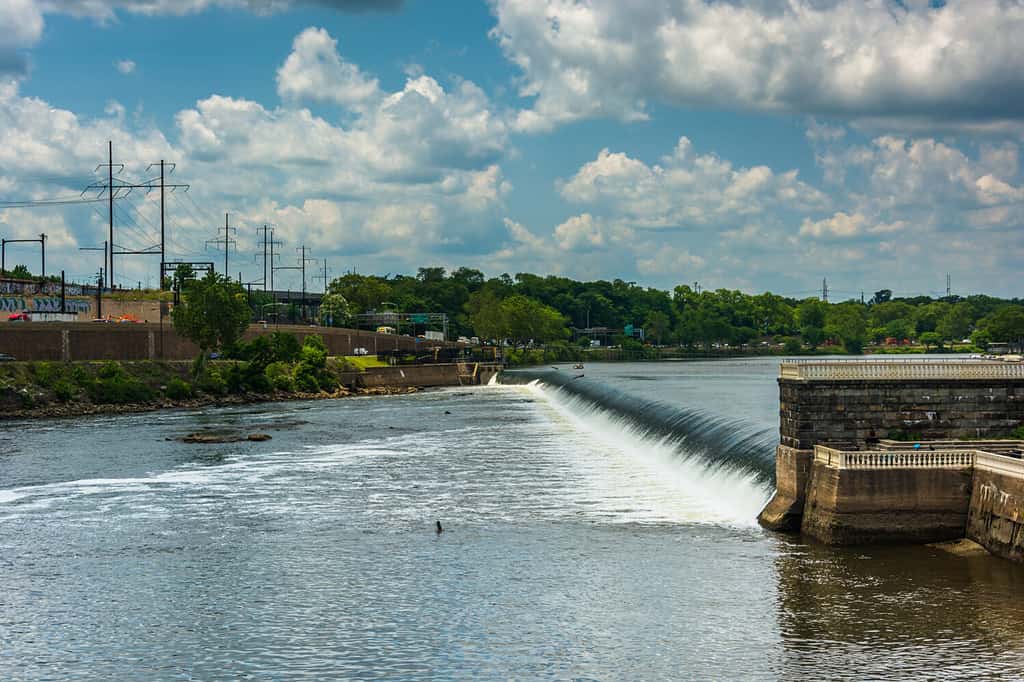
The Schuylkill River is great for those wanting to raft near Philadelphia.
©ESB Professional/Shutterstock.com
Rafters may enjoy a picturesque journey on the Schuylkill River that offers something unique. Due to the fact that this 128-mile river is a State and National Heritage Area, there are a variety of attractions to see along the way, including historical, societal, and natural treasures.
A distinctive way to learn about some of the most important events in American history is to paddle past historic river communities along the Schuylkill River Trail. When you want to mix the sights with nature excursions, supervised rafting excursions are offered along the river.
Rafting enthusiasts visiting Pennsylvania might wish to go around one of the Sojourn festivals in the springtime. Then, you’re able to go on trips on the water with larger groups. Although many paddlers complete their 115-mile journey over multiple days, many others only sign up for one day.
7. Delaware River
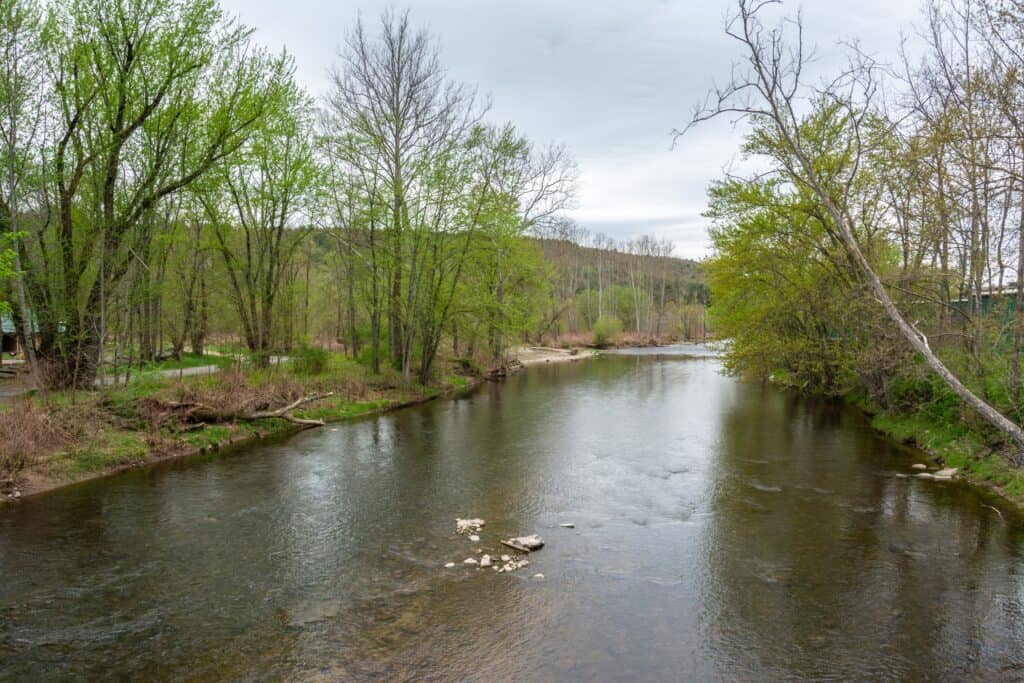
This river flows through five states!
©Alizada Studios/Shutterstock.com
The Delaware River is one of the most common places to go whitewater rafting in Pennsylvania. The river receives water from five reservoirs, therefore there are constant rapids all year long and the water levels are a bit more steady than in other waterways.
Cliffs and crystal-clear water are both present in the surroundings along the Delaware River. This river is an excellent choice for individuals who prefer taking in the landscape because it does not have a lot of intense white water.
People rafting in this area appreciate the Delaware River Gap because it offers both calm water and minor rapids. If you are not yet prepared to navigate the river by yourself, there are plenty of outfitters to choose from that have guided tours available.
Tips For Whitewater Rafting in Pennsylvania

Outfitters require different safety procedures, but all require life jackets and helmets.
©joshschutz/iStock via Getty Images
Even though it’s evident, if you’re not paying attention, you can find yourself swimming while on a rafting excursion. Pay heed to the orders from our guide and the rocks. If the boat runs into a rock, grab the paddle firmly and sit back down to resume paddling.
If you tumble out of the boat, don’t be upset. Grab it before drifting away. If this isn’t possible, there should be another raft close behind. Always listen to the safety speech an outfitter gives before hitting the water.
Swimming methods exist to determine whether you will fall out or plunge into the water for enjoyment. It involves you lying on your back with your head up slightly. This allows your feet and legs to act as shock absorbers if you hit a rock. Keep your knees slightly bent to avoid any serious injury.
Since white water rafting is an activity that is possible from the middle of spring to mid-fall, you must pick the optimal time for your excursion. The ideal season to go river rafting for adrenaline junkies is in the spring and early summer.
No matter how difficult your rafting route is, you should always wear a safety helmet. Additionally, while using a personal flotation device increases safety while rafting, it is only effective if all buckles are fastened.
In addition, the jacket shouldn’t be too loose that you are unable to breathe but sufficiently tight that you are unable to lift it off your head.
Summary of the Best Rivers For Whitewater Rafting in Pennsylvania
| River | Length |
|---|---|
| Youghiogheny River | 134 miles |
| Stonycreek River | 46 miles |
| Allegheny River Water Trail | 107 miles |
| Lehigh River | 109 miles |
| Susquehanna River Water Trail | 500 miles |
| Three Rivers Water Trail | 75 miles |
| Schuylkill River | 135 miles |
| Delaware River | 330 miles |
The photo featured at the top of this post is © Digital Vision./Photodisc via Getty Images
Thank you for reading! Have some feedback for us? Contact the AZ Animals editorial team.






